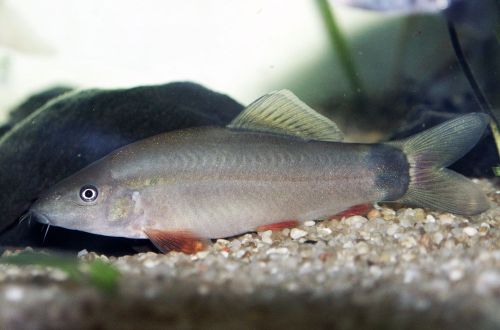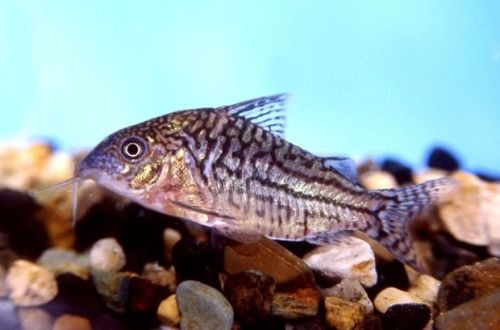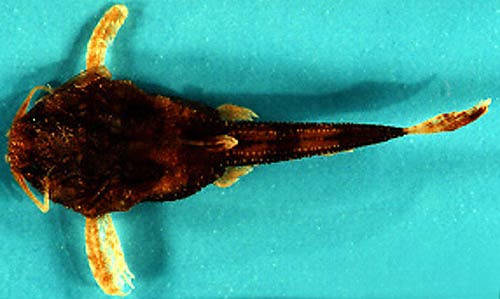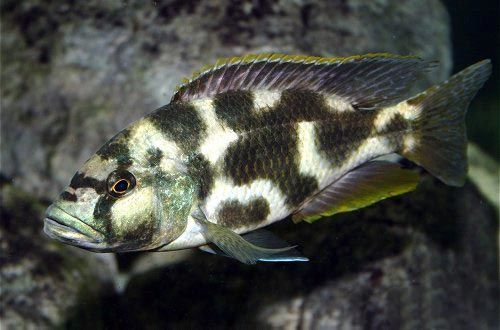
Livingstone’s cichlid
Livingston’s cichlid or Livingston’s Haplochromis, scientific name Nimbochromis livingstonii, belongs to the Cichlidae family. The second name is considered obsolete, since the fish was transferred to the new genus Nimbochromis, therefore it is more correct to refer to it as Livingston’s Nimbochromis.
A large beautiful cichlid, impressive size and unusual behavior make it an interesting object for observation. This is an ambush predator that has developed a unique ambush hunting mechanism – the fish pretends to be dead and lies on the bottom, in this position it can lie for a long time. When a small fish swims nearby, the Livingston Cichlid will immediately attack it.

This species is quite simple to keep and not as demanding on water quality as other cichlids, however, its considerable size, and adults reach 25 cm, implies an appropriate aquarium.
Requirements and conditions:
- The volume of the aquarium – from 450 liters.
- Temperature – 23-28°C
- pH value – 7.0-8.0
- Water hardness – medium hardness (10–19 dH)
- Substrate type – sand
- Lighting – moderate
- Brackish water – allowed at a concentration of 1,0002
- Water movement – strong / moderate
- Size is about 25 cm.
- Nutrition – meat products
- Life expectancy – up to 10 years.
Habitat
Endemic to Lake Malawi (another name for Nyasa), widely distributed throughout the lake. It lives both at a relatively shallow depth along the coastline, and at depths up to 100 meters. These areas tend to have soft substrata of silty mud and sand with dense vegetation from plants of the genus Vallisneria (Vallisneria).
Description
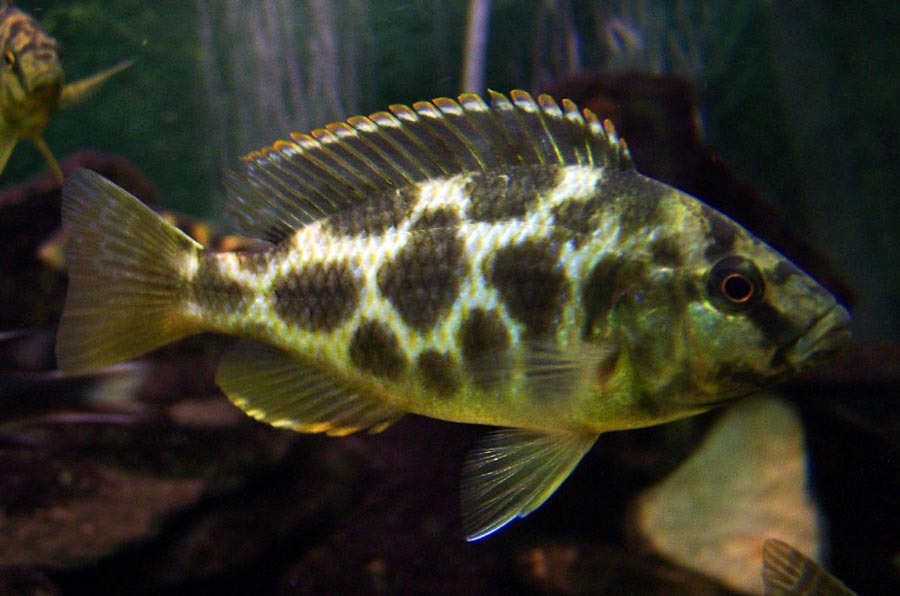
A large fish with an elongated body and a large mouth, reaching a length of 25 cm. The coloration varies from silvery, yellowish and blue with contrasting patterns, the spots flow into each other randomly. The body pattern is unique for each fish. Along the edge of the fins there is a strip of a different color, usually orange or red. Females and juveniles are less colorful than males, which have a richer blue color that intensifies during the mating season.
Coloration and body pattern are similar to another member of the Golden Leopard cichlid family (Nimbochromis venustus) and are sometimes confused both in articles and in non-professional pet stores, supplying one instead of the other.
Food
In the wild, they feed on live fish and shellfish, but at home there is no need to feed in the same way. Fish gladly accepts pieces of fish meat, shrimp, worms. Small amounts of herbal supplements, such as dried spirulina flakes, should be included in the diet. Feed juveniles once a day, adults three times a week. Overfeeding is unacceptable.
Maintenance and care
Successful maintenance is possible in a spacious aquarium from 450 liters. The design uses a sandy substrate with areas of dense vegetation of Vallisneria (Vallisneria). In one part of the aquarium there are large rocks and fragments of wood (snags, branches), they form natural shelters. The ground must consist of soft sand or similar material, no particles with sharp edges are allowed, they can scratch the fish.
The aquarium is filled with slightly alkaline water of medium hardness, a small salt concentration in the proportion of 2-3 grams per liter is acceptable. For more information on how to change the pH and dH parameters, see the “Hydrochemical composition of water” section. The Livingston cichlid will also adapt to lower pH values, but it should be above neutral. Maintenance of high quality and purity of water is ensured by its weekly renewal by 10–20% of the volume of the tank and the installation of an effective filtration system. Choose the most efficient filter available for your price. Of no small importance is the regular cleaning of the substrate from organic residues by a siphon. Other minimum equipment required includes heating, lighting and aeration systems.
Behavior
A predatory but peaceful species in relation to relatives of similar size and temperament, all other small species are potential food. Prefers a solitary lifestyle, males are not tolerant of each other and arrange deadly fights for territory and females during the spawning period. If breeding is planned, then a group of fish with one male and several females will be the best solution.
Breeding / Reproduction
Breeding is quite simple and does not require special preparations, except for the huge aquarium needed for a group of fish. Not every aquarist can afford a tank over 500 liters. Fish form polygamous families with one male and several females (at least three). During the spawning period, the male acquires a more intense color and lures the females to the spawning grounds, which are flat stones at the bottom. The female lays up to 100 eggs, which she immediately takes into her mouth – a protective evolutionary mechanism characteristic of African lake cichlids. An interesting mechanism has been developed for fertilization. On the anal fin of the male there are bright spots that look like eggs. They mislead the female, and she tries to swallow them, at this moment the male releases milk while breathing, fertilization occurs.
The entire incubation period, the eggs are in the mouth of the female, parental care continues in the first weeks after the appearance of the fry. Juveniles are fed with finely chopped meat pieces.
Fish diseases
Malawian bloat disease is a disease that occurs in this species when their dietary requirements are not met. They are also extremely sensitive to water quality, under improper conditions, clouding of the eyes and infection with various bacterial or fungal infections are possible. Read more about symptoms and treatments in the Aquarium Fish Diseases section.



